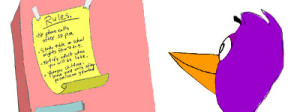 What is your rule structure? What rule structure is best for your child’s growth and development? By ‘rule sructure’ I’m not referring to the family rules that you have established for your household; this is the internal rule structure that you use to gain what you want in life, an important part of how you operate, which impacts how you communicate with your others, including your children.
What is your rule structure? What rule structure is best for your child’s growth and development? By ‘rule sructure’ I’m not referring to the family rules that you have established for your household; this is the internal rule structure that you use to gain what you want in life, an important part of how you operate, which impacts how you communicate with your others, including your children.
A typical rule pattern is a ‘my rules for me/my rules for you’ (my/my) in which the person has rules for themselves and for others. My/my parents willingly communicate their rules to their children (to everyone actually) because they think that people are similar and what is good for them will also suit other people. When raising kids this is often the most appropriate mode to be in.
“If I were you, I would…”
“Don’t do that!”
”Don’t touch that!”
“Sit up straight”
The next most typical pattern is a ‘my rules for me/your rules for you’ (my/your) structure. These people know the rules to follow but may be reluctant to communicate them to others. They have a “live and let live” perspective believing that everyone is different. This makes these people unclear to others on their expectations, but they are very good at understanding both sides of a position. Sometimes this is the appropriate mode for parenting children.
What isn’t good for developing children are the two other rule structures, only used by 10% of the adult population. One of these is ‘no rules for me/my rules for you’ (no/my) pattern and the other one is ‘my rules for me/I don’t care about you’ (my/-). The former are people who are ignorant of the rules but perfectly willing, when they learn them, but to pass them on to others. These are the regrettable “Do as I say, not as I do” parenting moments.
When parents allow themselves to slip into no/my mode, a mixed message is sent to their children that does not provide direction or help in making future decisions. The latter is your rude neighbor who keeps you up with loud parties at all hours and no concern for your rest. If a parent has a my/I don’t care rule structure on behavior it is very confusing for the child; the parent does as he pleases with no concern for how his behavior affects others, creating a bad influencing role model for developing children to emulate.
Parents with a my/my structure (75% of the adult population) make their expectations very clear to their children. When they shift into my/your structure, the older child realizes that the parent is trying to understand who he is and what he wants (your rules) as well as delivering the parent’s expectations (my rules). Both of these communication patterns help children grow and develop.
COMMUNICATION TAKEAWAY: We all operate with rules of behavior that we apply to ourselves and to others. When you are raising children, this is the ability or willingness to manage our own behavior and the behavior of our children. Once the patterns are recognized as patterns, they can be changed as the situation warrants. The key to good communication is recognizing that there is always a choice to our own behavior and that our choice impacts those around us, especially impressionable children who are taking their cues from the adult role models.
